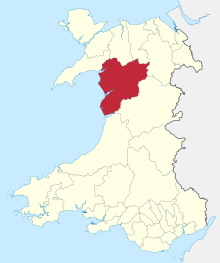Meirionnydd


Meirionnyddis a coastal and mountainous region ofWales.It has been akingdom,acantref,adistrictand, asMerionethshire,acounty.It is currently ancommittee areawithin the countyGwynedd.
Kingdom[edit]
Meirionnydd(Meirion, with-yddas a Welsh suffix of land, literally 'Land adjoined to Meirion') was a sub-kingdom ofGwynedd,founded according to legend byMeirion(derived from the Latin nameMariānus), a grandson ofCunedda,[1]a warrior-prince who brought his family to Wales from theHen Ogledd(the 'Old North', northernEnglandand southernScotlandtoday), probably in the early 5th century. His dynasty seems to have ruled there for the next four hundred years. The kingdom lay between theRiver Mawddachand theRiver Dovey,spreading in a north-easterly direction.

Cantref[edit]
The ancient name of thecantrefwasCantref Orddwy(or 'thecantrefof theOrdovices'). The familiar name coming from Meirion's kingdom.[1]
ThecantrefofMeirionnyddheld the presumed boundaries of the previous kingdom but now as afiefof theKingdom of Gwyneddwhere it continued to enjoy long spells of relative independence. It was divided into thecommotesofYstumanner(administered fromCastell y BereatLlanfihangel-y-Pennant) andTalybont(possibly centred onLlanegrynwhere there is a mound).[2]Thecantrefwas effectively abolished in 1284 following theStatute of Rhuddlanwith the area being reorganised with the addition of some neighbouringcantrefito form the county ofMerionethshire.
County[edit]
The area of Meirionnydd was enlarged under the Statute ofRhuddlanto become acounty,gaining the oldcantrefiofPenllynandArdudwy(shown asDunodingin the map of medieval cantrefi). The name for the county wasanglicisedto the English phonetic equivalent ofMerioneth,sometimes appearing with the suffix-shireasMerionethshire.[3]
Merioneth became anadministrative countywith an elected county council in 1889 under theLocal Government Act 1888.In 1974 the administrative county was abolished with most of the area merging withCaernarfonshireandAngleseyto create a new county ofGwynedd.
District[edit]
| Meirionnydd | |
|---|---|
| District | |
 Meirionnydd shown within Wales | |
| Population | |
| • 1971 | 29,531[citation needed] |
| • 1992 (estimate) | 32,900[citation needed] |
| History | |
| • Created | 1 April 1974 |
| • Abolished | 31 March 1996 |
| • Succeeded by | Gwynedd |
| •HQ | Dolgellau |
The 1974 reforms established a two-tier system, with upper-tier county councils and lower-tier district councils. The county of Gwynedd was divided into fivedistricts,one of which was calledMeirionnydd,reverting to the Welsh spelling of the nameMerioneth.[4]The district ofMeirionnyddcovered almost the same area as the pre-1974 county of Merioneth, excluding only theEdeirnionRural District, which went to theGlyndŵrdistrict ofClwyd.The Meirionnydd district replaced eight former districts:[5]
- BalaUrban District
- BarmouthUrban District
- Deudraeth Rural District
- Dolgellau Rural District
- DolgellauUrban District
- FfestiniogUrban District
- Penllyn Rural District
- TywynUrban District
Under theLocal Government (Wales) Act 1994,the previous two-tier system of counties and districts was replaced with newprincipal areas(each designated either a "county" or a "county borough" ), whose councils perform the functions previously divided between the county and district councils. TheMeirionnyddarea merged with the neighbouringArfonandDwyfordistricts to become a county, which the government originally namedCaernarfonshire and Merionethshire.[6]During the transition to the new system, the shadow authority requested a change of name fromCaernarfonshire and MerionethshiretoGwynedd.The government confirmed the change with effect from 2 April 1996, one day after the new council came into being.[7]
Since 1996,Gwynedd Councilhas used the former Meirionnydd district as a committee area for discussing local matters.[8]
Political control[edit]
The first election to Meirionnydd District Council was held in 1973, initially operating as a shadow authority alongside the outgoing authorities until it came into its powers on 1 April 1974. Throughout the council's existence a majority of the seats on the council were held byindependents:[9]
| Party in control | Years | |
|---|---|---|
| Independent | 1974–1996 | |
Premises[edit]
The district council was based atCae PenarlâginDolgellau,which had been built in 1953 as the headquarters of the old Merioneth County Council. Since 1996 the building has served as an area office of Gwynedd Council.[10]
References[edit]
- ^abLloyd, John Edward(1912).A History of Wales from the Earliest Times to the Edwardian Conquest.Longmans, Green, and Co. p. 250.Retrieved16 April2015.
- ^Lloyd, John Edward(1912).A History of Wales from the Earliest Times to the Edwardian Conquest.Longmans, Green, and Co.p. 252.Retrieved16 April2015.
- ^Bowen, Ivor (1908).The Statutes of Wales.London: T. F. Unwin. p. 3.Retrieved15 November2022.
- ^"The Districts in Wales (Names) Order 1973",legislation.gov.uk,The National Archives,SI 1973/34,retrieved30 October2022
- ^"Local Government Act 1972",legislation.gov.uk,The National Archives,1972 c. 70,retrieved1 November2022
- ^"Local Government (Wales) Act 1994",legislation.gov.uk,The National Archives,1994 c. 19,retrieved8 November2022
- ^"Hansard: Written Answers".UK Parliament.2 April 1996.Retrieved3 October2022.
- ^"Committee details - Meirionnydd Area Forum".Gwynedd Council.Retrieved16 November2022.
- ^"Compositions calculator".The Elections Centre.4 March 2016.Retrieved16 November2022.
- ^"Contact us: Siopau Gwynedd".Gwynedd Council.Retrieved14 November2022.
